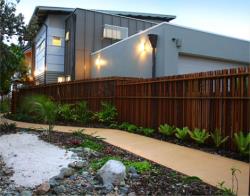Building a timber fence?
posted: 14/Mar/2016

Timber fences can provide an effective means of
- defining property boundaries
- providing privacy from the street or neighbours
- confining pets
- reducing traffic noise
- screening from sun and wind
- providing a safety barrier around swimming pools or other hazards.
If you are building a new timber fence you may consider the differences between using hardwood and or softwood. There is no Australian Standard or other grading requirements for fencing timber and the quality and cost can vary between different suppliers.
Timber sold for fencing could contain certain natural characteristics (knots, gum veins, minor insect damage, want, wane, etc.) and some movement (cupping, twisting etc.) can be expected. This timber quality is generally acceptable for domestic fencing situations.
Where a higher than normal appearance or performance is required for fencing, a higher quality timber should be specified. For posts and railings, structurally graded timber (e.g. cypress F5, hardwood F11, treated pine F5 or MGP10) could be used. For palings the following limitations could be specified:
- no loose or unsound knots
- no decay or insect galleries
- no heart or pith
- gum, latex or resin pockets not to extend from one surface to another
- sound knots not to exceed 50% of face width.
Note: Higher quality material could be at a higher cost than normal fencing timber
SPECIES SELECTION
To achieve a satisfactory service life, the following timber is recommended for fencing:
- Cypress – Sapwood in posts shall be limited to 20% of cross section and a maximum of 1/3 the width on adjoining faces.
- Hardwood - Posts - In-ground Durability Class 1 or 2 - Rails & Palings - Above Ground Durability Class 1 or 2
- Preservative treated pine.
PRESERVATIVE TREATMENT
All pine and hardwood containing sapwood should be be preservative treated.
Posts (and plinth boards where used) should be treated to a minimum hazard level H4. Palings, rails, cappings etc., should be treated to a minimum hazard level H3.
For pricing on timber for fencing talk to your local Accredited Queensland Timber Merchant.
Previous Articles
Cypress is a natural for all your building needs - particularly to avoid termites!
New WoodSolutions Guides show commercial and multi-residential building costs are cheaper with wood!
Imagine if glues and nails became a thing of the past and we all start to weld wood!